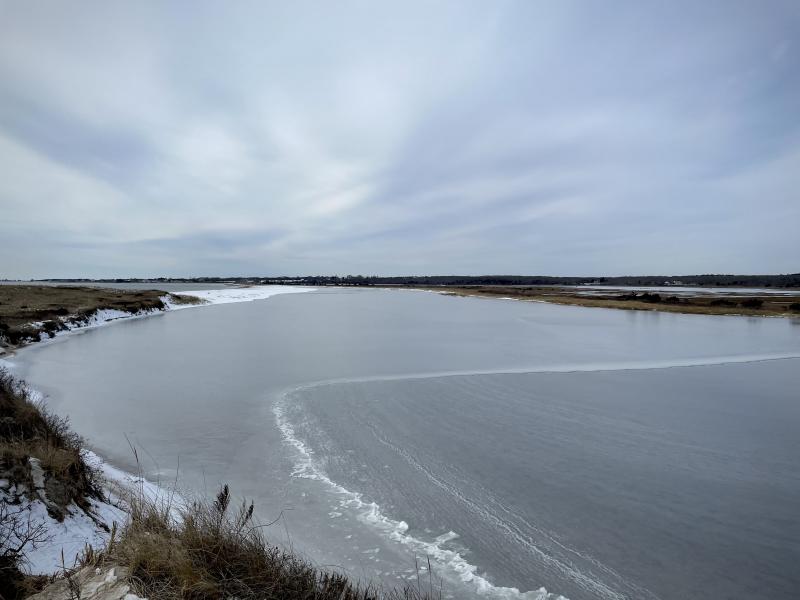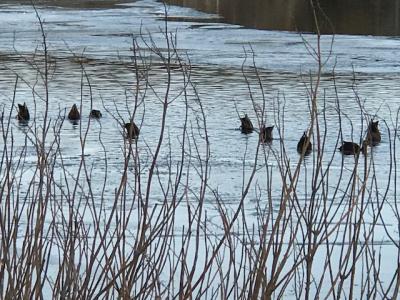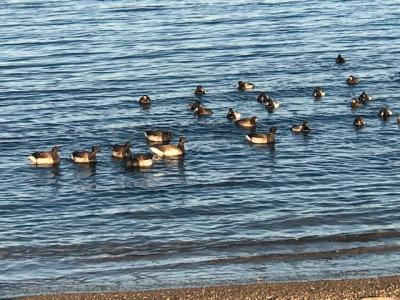Ice Returns in Force on Frigid Final Count of Lloyd Center’s 34th Annual Winter Waterfowl Survey
The last time temperatures were cold enough to cause ice to form on coastal ponds and estuaries surveyed for the Lloyd Center Winter waterfowl survey was the 2014/’15 season, which was the third consecutive season of high ice coverage for the traditionally colder January survey when more migrants have arrived. Two of those years featured low counts due to the ice, the 2014/’15 season showing higher numbers only due to an increase in Canada Geese, known to rest on ice and utilize nearby fields. What followed were consecutive years of low to moderate ice coverage and balmy temperatures for January counts, including the 60 degree day a year ago on January 26, 2020, when heavy rains had also caused higher than usual tides. Balmy conditions continued for the December 13, 2020 count, with the winter waterfowl conversation focusing on global warming.
For this past count on January 31, 2021, we’ll remember morning temperatures in the single digits that instead conjured images of past ice ages, as most ponds were at full or no less than 95% ice coverage. Allens Pond (pictured) while being shallow with extensive salt marsh and shallow creeks, is technically a flowing estuary that had more ice coverage than seen in many years. Although bitter cold and ice coverage were the stories, low winds and moderate tides made for otherwise good waterfowl survey conditions.
As expected, overall waterfowl numbers declined from last January, from 5,687 to 4,975, for the lowest January survey since that last extensive ice coverage season of 2014/’15. In fact, the December 2020 numbers (4,429) were uncharacteristically similar to the January count. Although frozen freshwater brings more birds south, except for geese and a few other species, frozen estuarine waters drive birds out of the study area into the unfrozen open bay. This is especially true for divers such as scaup that prefer open ponded areas, but also more common estuary divers including bufflehead, common goldeneye, and red-breasted mergansers. Each of these species had more water available in December. “Mergs” prefer fish and prefer more vast open embayments, while buffleheads and goldeneye consume more invertebrates and vegetation present in shallow flowing estuaries that had less ice coverage and therefore showed less decline.
It’s no surprise that the Slocums River (1,320), the Westport River (1,261), and Apponagansett Bay (817), all large, flowing estuaries, had by far the most waterfowl, the Slocums exceeding the much larger Westport due to less ice coverage. Vast shallow sections of the Westport compared to deeper flowing portions of the Slocums and Apponagansett Bay are factors contributing to the ice difference. The Slocums had the most geese (568), black duck (388), and bufflehead (192), although Westport River bufflehead numbers (135), usually relatively high, were comparable.
In addition to being optimal for shallow divers such as bufflehead and goldeneye (declined but most abundant at Slocums), the Slocums River with its shallow coves and forested buffer is optimal for dabblers, particularly black ducks, as a shallow water winter food source. Although less common winter dabblers such as American Wigeon and Gadwall declined, the more common American Black Ducks and Mallards both increased from last year, due in part to this being their only food source. Black ducks directly utilize estuaries as a winter food source rich in invertebrates, while Mallards are forced to these systems when their preferred ponds at local parks and other freshwater areas ice over. Mallards were most abundant at Nannaquaket (195) and the Slocums (185), both of which have open water near freshwater flows where they congregate. This habitat may be critical in winter for mallards which likely target a plant food source more abundant near freshwater. At Apponagansett Bay where Canada Geese (557) and Bufflehead (129) were abundant, geese were seen feeding in the estuary and resting on ice, while Bufflehead were distributed throughout this system as usual.
Of note were 210 Ring-necked ducks on Round Pond, which were absent last January and increased from December totals (43) at this same site, this flock mostly resting on ice. This depicts the usefulness of ice to waterfowl other than geese, with this resting activity likely serving to both preserve warmth during cold periods, and evade predators.
This waterfowl season was one of extremes, where we’re reminded how important surveys over time are for detecting trends and importance of the resource. All of these systems are used by wintering waterfowl when available, and during cold icy stretches, the estuaries are particularly critical. As we continue to monitor other aspects of these systems including their water quality, we’re reminded that their health is critical to this important aspect of avian biodiversity in the region.
by Jamie Bogart, Lloyd Center Research Associate

















